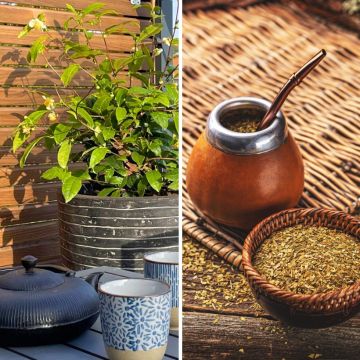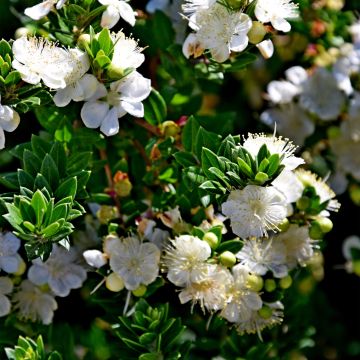

Ilex setchuenensis - Sechuan Holy
Ilex setchuenensis
Sechuan Holy
Special offer!
Receive a €20 voucher for any order over €90 (excluding delivery costs, credit notes, and plastic-free options)!
1- Add your favorite plants to your cart.
2- Once you have reached €90, confirm your order (you can even choose the delivery date!).
3- As soon as your order is shipped, you will receive an email containing your voucher code, valid for 3 months (90 days).
Your voucher is unique and can only be used once, for any order with a minimum value of €20, excluding delivery costs.
Can be combined with other current offers, non-divisible and non-refundable.
Why not try an alternative variety in stock?
View all →This plant carries a 24 months recovery warranty
More information
We guarantee the quality of our plants for a full growing cycle, and will replace at our expense any plant that fails to recover under normal climatic and planting conditions.
Would this plant suit my garden?
Set up your Plantfit profile →
Description
Ilex setchuenensis is a rare botanical holly in cultivation, which bears a strong resemblance to Ilex crenata. This evergreen bush with small, shiny, non-prickly oval leaves and a dense, compact habit is ideal for creating hedges at human height and has the advantage of growing faster than boxwood. It tolerates pruning well and is suitable for topiary. Plant it in a sunny or semi-shaded position, preferably in non-calcareous soil. Perfect in a Japanese garden, it also fits well in French-style gardens and makes a beautiful feature in a container on the terrace.
Ilex setchuenensis is a shrub in the Aquifoliaceae family. It has a moderately fast growth rate and a bushy, compact, and branched habit. At maturity, when allowed to grow freely, it will reach an average height of 1.75m (6ft) with a spread of 1.50m (5ft). Its small leaves, measuring 1.5cm (1in) in length, are slightly longer and more oval-shaped than those of Ilex crenata. Tough and glossy, the leaves are a medium green colour, lighter when young, with serrated edges but non-prickly. All hollies are dioecious plants, meaning there are male and female individuals. Only the female hollies bear fruit. The female holly produces small, insignificant but fragrant flowers in spring, with a dull white colour, which will develop into fleshy, round, shiny black berries after being pollinated by a nearby male holly. Identifying the sex of the flowers requires a trained eye; they all have four white petals and a waxy surface, but the male flowers can be recognised by their four prominent yellow anthers, while the female flowers have a short, green, oval-shaped pistil. The same shrub can produce both male and atrophied female flowers that cannot be pollinated. The seeds are dispersed by birds that are attracted to the fruits.
Faster-growing and more easily shaped to one's fancy than boxwood, Ilex setchuenensis holly will satisfy gardeners who enjoy French-style gardens, well-trimmed hedges, and plant sculptures, as well as collectors of rare plants. It is perfect for hedges, whether single-species or mixed, along with Elaeagnus, Laurustinus, or Mexican orange blossom. It primarily dislikes excessive sunlight and lime-rich soil, which cause its beautiful foliage to turn yellow, and prefers well-drained, loose, deep, and fairly fertile soil. Hardy, it thrives in semi-shaded areas, such as woodland edges or undergrowth, in a large natural garden. When grown in isolation, shaped into topiary, or trained as a small tree, it becomes a focal point in winter. It can also be used in large containers. Plant it generously in Zen gardens alongside bamboo, Japanese maples, camellias, etc. This holly also performs well in pots.
Hollies are both beloved and misunderstood plants. The genus comprises nearly 800 deciduous or evergreen species, generally native to the temperate Northern Hemisphere. These ancient plants have experienced alternating periods of glaciation and dry, hot periods in our climatic history, making them extremely adaptable and resilient. Their wood, which ranges from white to cream, is very low in water content, even when green. It is dense and heavy but soft and easy to work with in woodworking. It is also an excellent fuel for heating, usable even when green. Finally, its foliage and (inedible) berries are rich in caffeine.
Plant habit
Flowering
Foliage
Botanical data
Ilex
setchuenensis
Aquifoliaceae
Sechuan Holy
Other Ilex - Holly
View all →Planting and care
To plant Ilex setchuenensis, add a generous contribution of potting compost and incorporate it into the soil of your garden, in order to slightly acidify the soil while enriching it. If your soil is rich in active limestone, the holly will tend to develop chlorosis (the foliage gradually turns yellow around the leaf veins). Choose a semi-shaded or sunny location that is not scorching. Follow the watering (with non or low limestone water) for the first 3 years, especially in the summer, in case of prolonged drought, to help the bush establish itself. When you want to give a specific shape to this holly, prune it twice a year: first in early summer, then in September-October. Ilex can be attacked by holly leaf miners, white scale insects in spring, and mites and aphids in summer. Optionally, apply a preventive treatment at the beginning of the season.
Planting period
Intended location
Care
Planting & care advice
This item has not been reviewed yet - be the first to leave a review about it.
Similar products
Haven't found what you were looking for?
Hardiness is the lowest winter temperature a plant can endure without suffering serious damage or even dying. However, hardiness is affected by location (a sheltered area, such as a patio), protection (winter cover) and soil type (hardiness is improved by well-drained soil).

Photo Sharing Terms & Conditions
In order to encourage gardeners to interact and share their experiences, Promesse de fleurs offers various media enabling content to be uploaded onto its Site - in particular via the ‘Photo sharing’ module.
The User agrees to refrain from:
- Posting any content that is illegal, prejudicial, insulting, racist, inciteful to hatred, revisionist, contrary to public decency, that infringes on privacy or on the privacy rights of third parties, in particular the publicity rights of persons and goods, intellectual property rights, or the right to privacy.
- Submitting content on behalf of a third party;
- Impersonate the identity of a third party and/or publish any personal information about a third party;
In general, the User undertakes to refrain from any unethical behaviour.
All Content (in particular text, comments, files, images, photos, videos, creative works, etc.), which may be subject to property or intellectual property rights, image or other private rights, shall remain the property of the User, subject to the limited rights granted by the terms of the licence granted by Promesse de fleurs as stated below. Users are at liberty to publish or not to publish such Content on the Site, notably via the ‘Photo Sharing’ facility, and accept that this Content shall be made public and freely accessible, notably on the Internet.
Users further acknowledge, undertake to have ,and guarantee that they hold all necessary rights and permissions to publish such material on the Site, in particular with regard to the legislation in force pertaining to any privacy, property, intellectual property, image, or contractual rights, or rights of any other nature. By publishing such Content on the Site, Users acknowledge accepting full liability as publishers of the Content within the meaning of the law, and grant Promesse de fleurs, free of charge, an inclusive, worldwide licence for the said Content for the entire duration of its publication, including all reproduction, representation, up/downloading, displaying, performing, transmission, and storage rights.
Users also grant permission for their name to be linked to the Content and accept that this link may not always be made available.
By engaging in posting material, Users consent to their Content becoming automatically accessible on the Internet, in particular on other sites and/or blogs and/or web pages of the Promesse de fleurs site, including in particular social pages and the Promesse de fleurs catalogue.
Users may secure the removal of entrusted content free of charge by issuing a simple request via our contact form.
The flowering period indicated on our website applies to countries and regions located in USDA zone 8 (France, the United Kingdom, Ireland, the Netherlands, etc.)
It will vary according to where you live:
- In zones 9 to 10 (Italy, Spain, Greece, etc.), flowering will occur about 2 to 4 weeks earlier.
- In zones 6 to 7 (Germany, Poland, Slovenia, and lower mountainous regions), flowering will be delayed by 2 to 3 weeks.
- In zone 5 (Central Europe, Scandinavia), blooming will be delayed by 3 to 5 weeks.
In temperate climates, pruning of spring-flowering shrubs (forsythia, spireas, etc.) should be done just after flowering.
Pruning of summer-flowering shrubs (Indian Lilac, Perovskia, etc.) can be done in winter or spring.
In cold regions as well as with frost-sensitive plants, avoid pruning too early when severe frosts may still occur.
The planting period indicated on our website applies to countries and regions located in USDA zone 8 (France, United Kingdom, Ireland, Netherlands).
It will vary according to where you live:
- In Mediterranean zones (Marseille, Madrid, Milan, etc.), autumn and winter are the best planting periods.
- In continental zones (Strasbourg, Munich, Vienna, etc.), delay planting by 2 to 3 weeks in spring and bring it forward by 2 to 4 weeks in autumn.
- In mountainous regions (the Alps, Pyrenees, Carpathians, etc.), it is best to plant in late spring (May-June) or late summer (August-September).
The harvesting period indicated on our website applies to countries and regions in USDA zone 8 (France, England, Ireland, the Netherlands).
In colder areas (Scandinavia, Poland, Austria...) fruit and vegetable harvests are likely to be delayed by 3-4 weeks.
In warmer areas (Italy, Spain, Greece, etc.), harvesting will probably take place earlier, depending on weather conditions.
The sowing periods indicated on our website apply to countries and regions within USDA Zone 8 (France, UK, Ireland, Netherlands).
In colder areas (Scandinavia, Poland, Austria...), delay any outdoor sowing by 3-4 weeks, or sow under glass.
In warmer climes (Italy, Spain, Greece, etc.), bring outdoor sowing forward by a few weeks.
































































